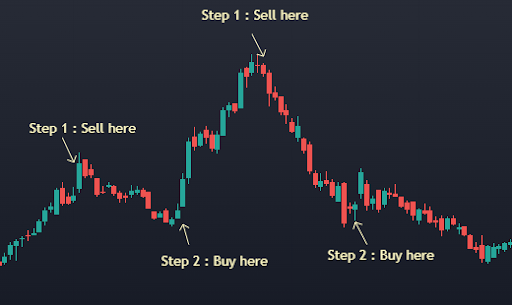What is the difference between Long & Short?

What exactly does "shorting" or "going short" indicate? I'll explain everything to you. When we talk about the financial market then there are two ways through which money can be made :
- Going Long/ Long Position
- Going Short/ Short Position
When the price of a financial instrument (stock, bonds, commodity etc.) appreciates (rise) or depreciate (fall), a trader can book profit.

When you're in a Long position, first you buy an asset, and you wait for the price appreciation, then sell it to book profit. "Buy" and "Long" are used interchangeably.

When you're in a Short position, first you sell an asset, and you wait for the price depreciation, then buy it to book profit. "Sell" and "Short" are used interchangeably.
But wait! Is it possible to sell the stocks that you don't own? The answer is "Yes" and it is called "Short selling". Your broker will provide this facility to you. You need not worry and in return, they'll charge you some minimal amount as interest. All the settlements of sell and buy will be managed by your broker.
When you're in a Short position, first you borrow an asset, then sell it, and you wait for the price depreciation (fall). If the price goes down you can buy back the stocks at a lower price and book profit. At this point, you may be confused about how short selling works but don't worry.
Let's understand this Short position with an example for better clarity. First you borrow : 100 stocks (through you broker) then sell it : @ $70 per unit Total invested or selling amount : 100 × 70 = $7,000
Here your broker doesn't care the price will go up or down. Your broker wants its stock back in the given time.
Now the price decreases to $65 Now you'll buy : 100 stocks (from the market) Buying price is : @ $65 per unit and return it to your broker Total invested or buying amount : $6,500 Earned profit : $7,000 - $6,500 = $500
Decoding Risk/Reward (R/R)
Let's take an example for better understanding the Risk/Reward (R/R) wrap in the Long or Short position-
Case Ⅰ : Long Position
You have bought 100 stocks of "XYZ" company at $50 per unit. Your total investment amount is $5000
Now at this moment, only two scenarios are possible i.e
Scenario Ⅰ : Price will appreciate (increase).
Scenario Ⅱ : Price will depreciate (decrease).
In the first scenario your stock can go up like a rocket and you can book a decent profit.
But what if some misfortune occurred with the "XYZ" company (Scenario Ⅱ ). Now the stock price of the company will definetily fall and you've to book loss. Here even if the stock price goes down to $0, your maximum loss would be $5000 (only invested amount).
- Conclusion :
- Risk is limited in Long position.
- Profit is unlimited in Long position
Case Ⅱ : Short Position
You have sold 100 stocks of "XYZ" company at $50 per unit. Your total investment amount is $5000
Now at this moment, only two scenarios are possible i.e
Scenario Ⅰ : Price will appreciate (increase).
Scenario Ⅱ : Price will depreciate (decrease).
Here the situation is different, you've to pay attention, In the first scenario price can go up to $70 or $100 or $500 or non-finite (Nobody knows) and you have to book loss (this could be unlimited).
In the second scenario, if the price falls, you can book profit. In the worst case, it can go down to $0 and you can book only $5000.
- Conclusion :
- Risk is unlimited in the Short position.
- Profit is limited in Short position
| # | Long Position | Short Position |
|---|---|---|
| Entry | First buy an asset then sell it | First borrow an asset then sell it |
| Risk | Limited | Unlimited |
| Reward | Unlimited | Limited |
| Outlook | Hike in price | Decline in price |
| Exit Action | You sell an asset to make profit | You repurchase an asset for a profit and return it to the lender |